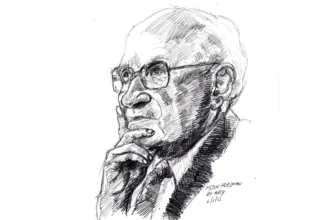Understanding Phenomenology and Its Relevance to Race
A phenomenology of race aims to understand race as changing, ambiguous, dynamic, and as a persistent feature in our social world. Race corresponds to the framework of phenomenology. The everyday use of the word phenomena refers to a rare fact or event. Within philosophy, phenomenology refers to a specific tradition.
Maurice Merleau-Ponty defines phenomena as a “layer of living experience through which other people and things are first given to us.” Initial contact with the world occurs phenomenally, rather than already clearly distinguishable as subjective or objective.
The lived world steers between the unnecessary setup of stark contrast, reducing the world to either that which exists out in the material world–the fallacy of the natural attitude–or to the projections of the inner self–the reduction to and prioritization of consciousness. The lived world is an open-ended framework with meaning complexes. Insisting that the world is already divided into the subjective and the objective misses the phenomenal quality of the world, the space of phenomenology.
Because race is not solely a natural difference, because the differences of race are not biologically significant, empiricist and positivist philosophical analysis cannot capture the functioning of race.
Phenomena include not only the influence of the world but also that of the subject. Phenomenology asserts that experiences of the world are negotiations between the intentions of the subject and the givens of the world.
To reconcile how people living in one society, in a shared world, can diverge and even completely disagree in understanding an experience/event, I was inspired to explore Merleau-Ponty’s phenomenology for its implications in the philosophy of race. These two branches of philosophy have had limited contact with each other. I follow the large body of feminist philosophy that engages Merleau-Ponty’s work because of his focus on embodiment.
Racism rebuffs the phenomenal structure of race.
The aim of phenomenology as a method lies not in describing the physical natural world, nor in the search for nous, truth, or the guiding principles of the universe, but in the more constrained and limited aim of describing human being-in-the-world for honesty and accuracy about what we can claim to know about the world. Because race is not solely a natural difference, because the differences of race are not biologically significant, empiricist and positivist philosophical analysis cannot capture the functioning of race.
Because reason, universal principles, or values do not guide human understandings and reactions to race, traditional normative philosophy cannot address the functioning of race. Phenomenology, as a philosophical framework and methodology, precisely addresses the conceptual space where race functions.
Race occupies the interstice within the natural and the social—precisely the domain of human being-in-the-world. Because race is an open-ended framework, with an indeterminate meaning complex, it promises to perennially function within the social horizon. Race’s persistence in its meaning’s creative transformations testifies to the impossibility of eliminating it from the social horizon. Race is a phenomenon.
Racism as Essentialism or Denying Race as Phenomena
Michael Omi and Howard Winant define racism as essentialism. They write, “[a] racial project can be defined as racist if and only if it creates or reproduces structures of domination based on essentialist categories of race.” In defining essentialism, they clarify, “a key problem with essentialism is its denial, or flattening, of differences within a particular racially defined group.” Racism, as a static, repetitive refusal to see or to think otherwise about people, precisely denies race’s phenomenological structure. Racism clings to the safety of a particular meaning or conception of the world.
![The photo shows several members of Asian Americans for Action along with their guests: Standing from left are guest Elsie Uyematsu [Osajima], Yuri Kochiyama, Minn Matsuda, and Aiko Herzig-Yoshinaga. Seated from left are a feminist from Japan [unnamed], Mitzi Sawada, guest Amy Tachiki [Uyematsu], and Lynn Yamashiro [Taise]. The photo was taken by Mary Uyematsu [Kao] in New York City, 1973, at the United Asians Center, highlighting their activism in race and social justice.](https://politicsrights.com/wp-content/uploads/2024/07/Asian_American_for_Action__1973_-Race.webp)
Focusing on human relations, Helen Ngo writes, “[t]he ontological violence of racism is not a violence against our subjectivity, as traditional accounts of racism would have it, but rather—and more urgently—a violence against our intersubjectivity. It is a violence against our embodied being-with.” Ngo posits that the overdetermined meanings of race and racialized subjects constrain our relations with each other, within already known scripts constricting our ability to get to know each other, to learn from each other, and to be surprised by the other.
To fully appreciate Ngo’s consternation regarding the violence against intersubjectivity, José Medina emphasizes social relations in our claims to knowledge, “epistemic appraisals always contain an element of social systematicity, even when they appear to be quite isolated.”
I want the insights from women of color to influence and form my philosophical thinking.
Because what we can claim to know is social, Medina juxtaposes identity with diversity, “issues of identity have to be understood as issues of diversity: the others are essential to the self . . . . In this view, diversity is the human condition.” In such emphasis on sociality and hence diversity, regarding epistemology and identity, Medina’s point parallels Ngo’s prioritization of the importance of building sincere relationships. Similarly, Mariana Ortega emphasizes building relations with others through coalition building.
This emphasis on relationality, sociality, and coalition building all grapple with this inherent condition of being-with-others and of being-in-the-world. Because of this ontological condition of situatedness, our knowledge claims are necessarily ambiguous, indeterminate, and phenomenal.
Racism denies recognizing such relationality; instead, racism essentialistically holds as static the racialized other. In other words, racism foregoes acknowledging race as open-ended, changing, and relational. Racism rebuffs the phenomenal structure of race.
Foregrounding Relationality with Whom
In acknowledging the importance of our relations with others, I take seriously the question of with whom to have relations. Because I want to develop deeper relations with women of color, I center their works.
There are those with whom there is no choice but to have relations. One cannot avoid engaging those comfortably situated because of the power they occupy and influence, intentionally or not. But considering the importance of with whom I am being-with–for my relationships form my subjectivity and my knowledge–I want to think carefully about with whom I develop relations. I want the insights from women of color to influence and form my philosophical thinking.
The identity is aspirational for political solidarity in the future.
The term “women of color” is a complicated term. Loretta Ross explains the introduction of the term in 1977 during the National Women’s Conference. Ross writes that with the term, “we named ourselves.”
She clarifies that “they didn’t see it as a biological designation . . . but it is a solidarity definition, a commitment to work in collaboration with other oppressed women of color who have been ‘minoritized.’” From its inception, the term was about naming oneself and building political solidarity.

The term faces some contestation because of its solid origins in the United States and the West. The term “women of color” arose from within the hegemonic western context. Acknowledging this context, the Santa Cruz Feminist of Color Collective understands the term, “women of color as a political identity-formation and not simply an identity-marker.” The Santa Cruz Feminist of Color Collective repeats Ross’s initial presentation.
The term “women of color” aims to respect diversity and name them as a unity, but this political forging identity is fragile. In respect of such fragility, I treat the term primarily as a self-ascribed term, a term a person chooses to self-apply. The identity is aspirational for political solidarity in the future. I utilize the term in this book, admitting that the term faces controversy, especially in an international context, but for its initial solidarity sense, in its aspirational context, for its political identity formation.
The term “women of color” functions as an indeterminate meaning complex. “Women of color” does not refer to a natural, biological term; it is a socially produced identity. The identity is fluid; both its unifying core and the parameters of the identity are unclear and subject to change depending on the context. As fluid and indeterminate, the identity structure is phenomenal. As such, this book does not explore a phenomenology of women of color, precisely because of the absence of a stable unity/essence or boundary.
In recognizing the phenomenal structure of the identity, this book analyzes how phenomenology as a framework and method in philosophy facilitates understanding this fragile solidarity identity. This book does not apply the phenomenologically descriptive method on the subject of women of color. I do not analyze testimonies from women of color about their experiences. Rather, this book explores the concepts circumscribing women of color, such as multiplicity and intersectionality, with phenomenological concepts for these concepts meaningfully speak and provide depth to each other.
This book analyzes how phenomenology as a framework and method in philosophy facilitates understanding this fragile solidarity identity.
The chapters in this book explain that perception, experience, and embodiment are phenomena. As phenomena, perception, experience, and embodiment serve as lenses to a phenomenology of race. Perception, experience, and embodiment enable the most intimate and immediate opening onto and connection with the world and other human beings. Yet, because they cannot be reduced to thing-like, atomistic structures, they eluded earlier philosophical endeavors. Rather, perception, experience, and embodiment function within relational, contextual, situated phenomenal structures.
The identity “women of color” is phenomenal; it does not have an essence, a unifying necessary and sufficient condition. The boundaries of the identity group change. Embodiment materially defines the identity group, but socially constructed ideas and meanings structure the embodiment and the identity. As such, the identity group remains ambiguous.
There are constraints from being-in-the-world; nevertheless, each racialized, gendered, embodied woman of color perceives and experiences the world similarly and differently. The subject, the woman of color, influences her phenomenological space and time. Each subject situated in the world influences and conditions the lived world. The philosophical framework of phenomenology can poignantly depict the social and conceptual ambiguity circumscribing women of color.









